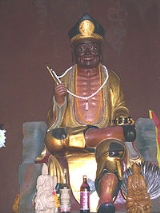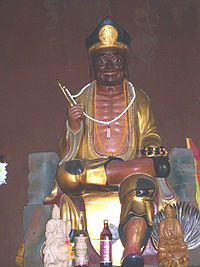
Daoji
Encyclopedia

Chan
-People:* Chan Marshall, American musician better known as Cat Power* Chan , Chinese surname; Mandarin transcription of the same name is Chen ** Agnes Chan , Hong Kong singer, also famous in Japan...
Buddhist monk of the Southern Song Dynasty in China
China
Chinese civilization may refer to:* China for more general discussion of the country.* Chinese culture* Greater China, the transnational community of ethnic Chinese.* History of China* Sinosphere, the area historically affected by Chinese culture...
. He was born with the name of Li Xiuyuan. (李修元). Some sources have cited his name as Lǐ Xiūyuán (李修缘, the only difference being the third character of his name). Dao Ji was also called Hu Yin (Recluse from the Lake) and Elder Fang Yuan (Square Circle).
Known for his wild and eccentric behavior while maintaining his compassionate nature, Ji Gong became a folk hero in China and was later deified in the Taoist community often invoked by oracles to assist in worldly affairs. Buddhists also invoke Ji Gong in folk stories and koans.
History
Born Li Xiuyuan to a former military advisor, Li Maochun, Daoji was born after his parents, who could not have children, entered a temple. Supposedly upon reaching the Hall of the Five Hundred Arhats, the statue of MahakasyapaMahakasyapa
Mahākāśyapa or Kāśyapa was a brahman of Magadha, who became one of the principal disciples of Śākyamuni Buddha and who convened and directed the first council. Mahākāśyapa is one of the most revered of the Buddha's early disciples, foremost in ascetic practices...
was knocked off its lotus throne.
After his parents' death, Li went to Hangzhou
Hangzhou
Hangzhou , formerly transliterated as Hangchow, is the capital and largest city of Zhejiang Province in Eastern China. Governed as a sub-provincial city, and as of 2010, its entire administrative division or prefecture had a registered population of 8.7 million people...
at the age of 18 and became a monastic at the famous Ling Yin Temple
Lingyin Si
Lingyin Temple is a Buddhist temple of the Chan sect located north-west of Hangzhou, Zhejiang Province, People's Republic of China. The temple's name is commonly literally translated as Temple of the Soul's Retreat...
near Hangzhou
Hangzhou
Hangzhou , formerly transliterated as Hangchow, is the capital and largest city of Zhejiang Province in Eastern China. Governed as a sub-provincial city, and as of 2010, its entire administrative division or prefecture had a registered population of 8.7 million people...
, and was ordained under the monastic name Daoji. Even though his eccentric behavior broke the rules of the vinaya
Vinaya
The Vinaya is the regulatory framework for the Buddhist monastic community, or sangha, based in the canonical texts called Vinaya Pitaka. The teachings of the Buddha, or Buddhadharma can be divided into two broad categories: 'Dharma' or doctrine, and 'Vinaya', or discipline...
(traditional code for monastics), it is said that Daoji was kind hearted and was always ready to lend a helping hand to ordinary people. Unlike a traditional Buddhist monk, he ate meat and drank wine. The monks, bewildered and fed up with his behavior, expelled Daoji from the monastery. From then on, Daoji roamed the streets and helped people whenever he could.
According to legends, while cultivating in the Buddha's teaching, Daoji was said to attain magical powers. Many who noticed his eccentric yet benevolent and compassionate nature began to think that he was an incarnate of a bodhisattva
Bodhisattva
In Buddhism, a bodhisattva is either an enlightened existence or an enlightenment-being or, given the variant Sanskrit spelling satva rather than sattva, "heroic-minded one for enlightenment ." The Pali term has sometimes been translated as "wisdom-being," although in modern publications, and...
, or as a reincarnate of an arhat. He was widely recognized by the public as the incarnate of the Taming Dragon Arhat , one of the eighteen legendary arhats.
When Daoji died at the Jing Ci monastery on the 14th day of 5th Lunar month (17 June 1207), syncretic
Syncretism
Syncretism is the combining of different beliefs, often while melding practices of various schools of thought. The term means "combining", but see below for the origin of the word...
Taoism
Taoism
Taoism refers to a philosophical or religious tradition in which the basic concept is to establish harmony with the Tao , which is the mechanism of everything that exists...
began to revere Daoji as a god from heaven and later adopted him as a deity
Deity
A deity is a recognized preternatural or supernatural immortal being, who may be thought of as holy, divine, or sacred, held in high regard, and respected by believers....
. Not long after that, Buddhism began to recognize Daoji's compassionate efforts and is involved in many classic koans.
The I Kuan Tao has also adopted him into their pantheon of deities, citing Zhang Tianran, contemporary founder of the I-Kuan Tao, as the incarnation.
Depiction
Ji Gong can usually be seen smiling in tattered monastic robes, and usually carries a bottle of wine in his right hand, and a fan (believed to be magical) in his left hand. He wears a hat with the Chinese character Fo(佛), meaning "Buddha". He can also be seen holding his shoes in his right hand. Because of his carefree nature, he is rarely ever shown with a serious facial expression.Daoji in popular culture
- The life of Daoji has also been popularized in a TV series which aired in 1993 called (in English) "Legends of Ji Gong."
- Comedic actor and director Stephen ChowStephen ChowStephen Chow Sing-Chi is a Hong Kong actor, comedian, screenwriter, film director and producer.- Professional career :Stephen Chow began as a temporary actor for TVB. He entered TVB in early 1980s, and was trained there, although he had few opportunities to appear in films. Chow graduated from...
portrayed Ji Gong in his 1993 movie Ji Gong (film). - In 2010, the Legend of Crazy Monk was based on Daoji screened on mainland China.

